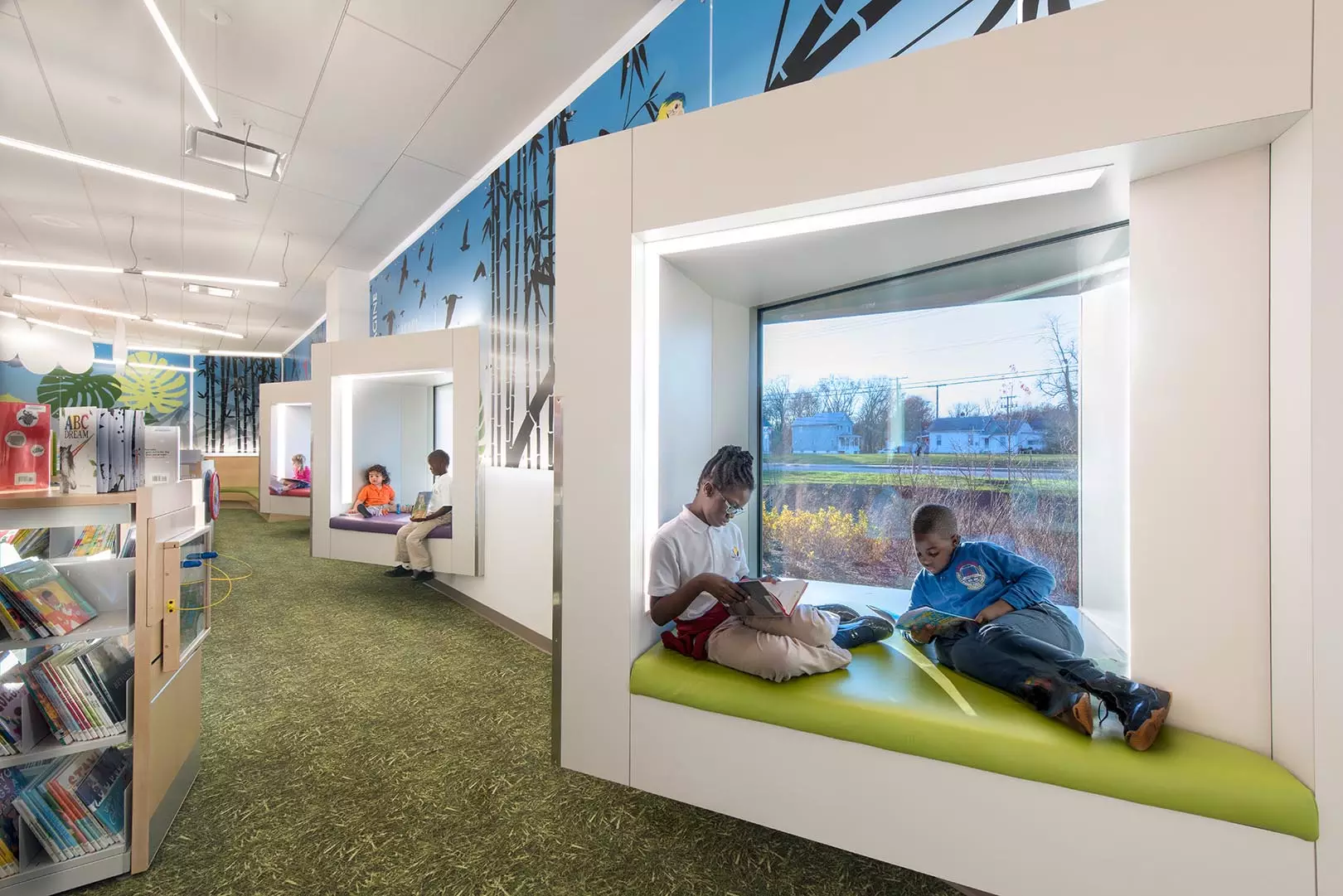The American Institute of Architects (AIA) and the American Library Association (ALA) are awarding six libraries with the 2018 AIA/ALA Library Building Awards for excellence in architectural design.
Traditional roles of libraries are evolving. Today, libraries are designed with larger gathering spaces to support the needs of the community and many include sustainable features to conserve water or energy. Both of these trends are reflected by this year’s AIA/ALA Library Building Award recipients.
Award recipient projects were selected by a six-member jury. This year’s jury included Daria Pizzetta, FAIA (Chair), H3 Hardy Collaboration Architecture, LLC; Sara A. Bushong, Bowling Green State University; Patrick Deaton, AIA, North Carolina State University Libraries; Terri M. Luke, Wake County Public Library, Cary, North Carolina; Christopher Noll, AIA, Noll & Tam Architects and Lisa Lintner Valenzuela, Johnson County Public Library, Franklin, Indiana.
The 2018 AIA/ALA Library Building Awards recipients are:
Austin Central Library; Austin, Texas | Lake Flato + Shepley Bulfinch
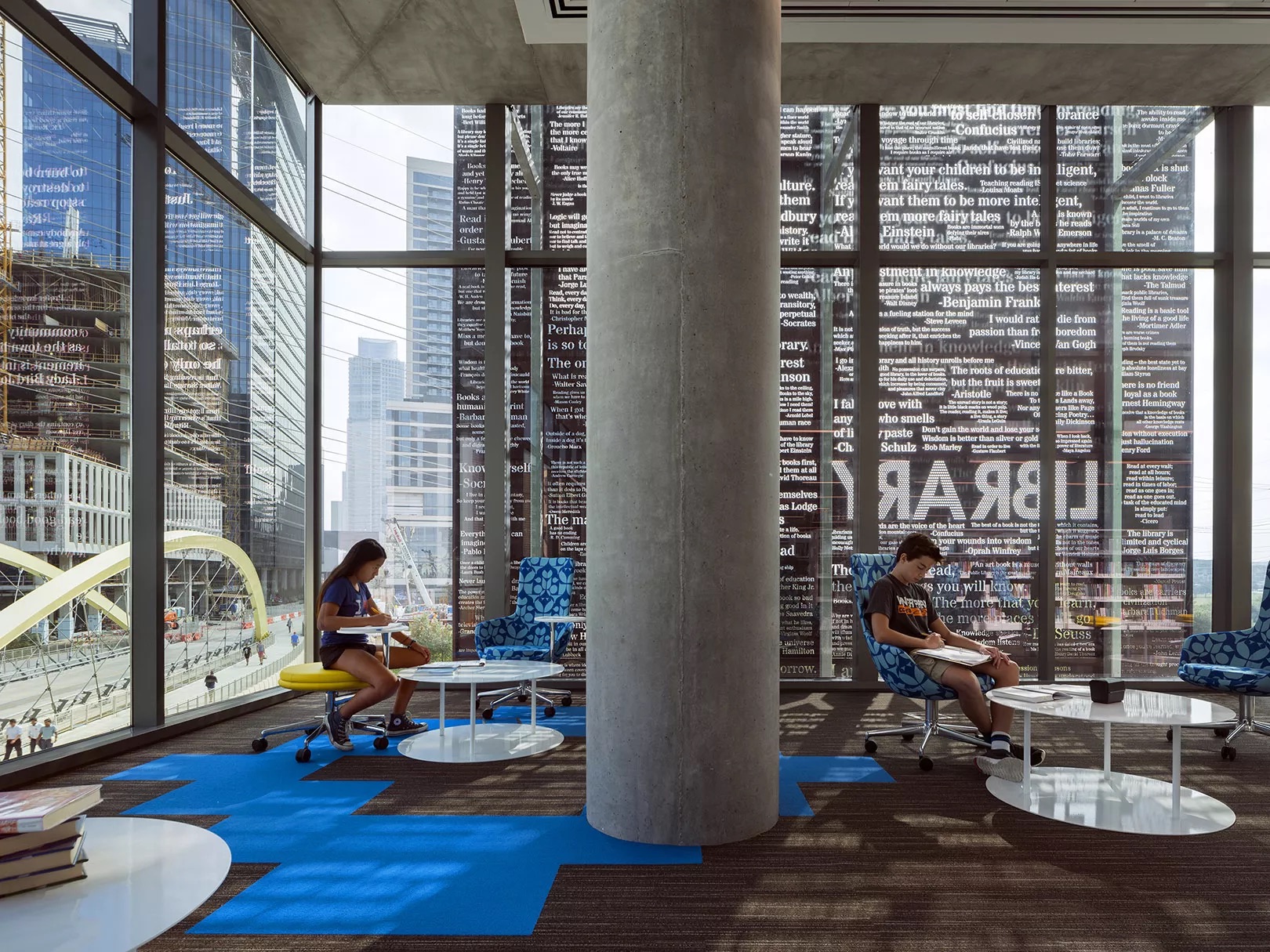
A technologically rich hub for innovation and cultural intelligence, the Austin Central Library has created a framework for lifelong learning that bolsters a more resilient community. Arguably the most daylit library in the nation, the nearly 200,000-square-foot building is defined by a light-soaked, six-story atrium surrounded by the book collections and event space. On track for LEED Platinum certification, the building respects the library system’s desire to be good stewards of water resources in an area of Texas that regularly experiences drought and is subjected to water restrictions. A 373,000-gallon cistern captures roof rainwater and HVAC condensate, which provides water in the restrooms as well as irrigation for the landscape and vegetated roof. Photo: Nic Lehoux via AIA
Eastham Public Library; Eastham, Massachusetts | Oudens Ello Architecture
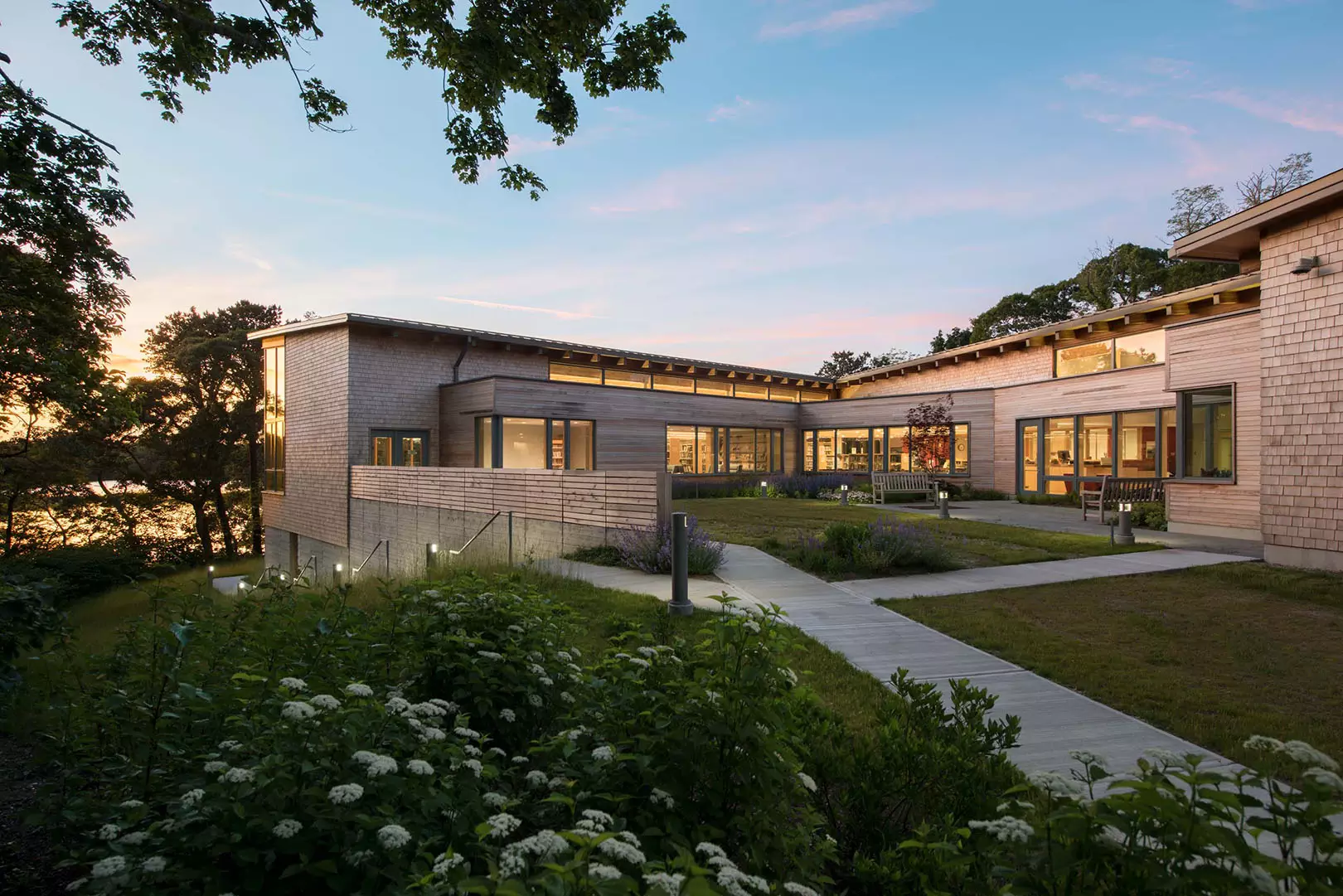
Since it opened in January 1898, the original one-room, 300-square-foot Eastham Public Library has undergone two additions as its collections and patron base grew. In order to meet the needs of today’s community, the design team replaced an outmoded 1980s addition with a sleek LEED Gold certified building that blurs the line between indoors and outdoors. The larger addition allowed for the library to double its size.
The majority of the new building mass was positioned at the rear of the site to reconcile the size of the addition to the original library, which is listed on the National Register of Historic Places. Overall, the building takes full advantage of the library’s waterfront setting while minimizing the visual impact on the small structure from the road. A palette of naturally weathering materials—cedar shingles and siding as well as bluestone flooring—relates the contemporary structure to its seaside location and vernacular of the historic building. Photo: Chuck Choi Photography via AIA
Hastings Public Library Renovation/Addition; Hastings, Nebraska | The Clark Enersen Partners
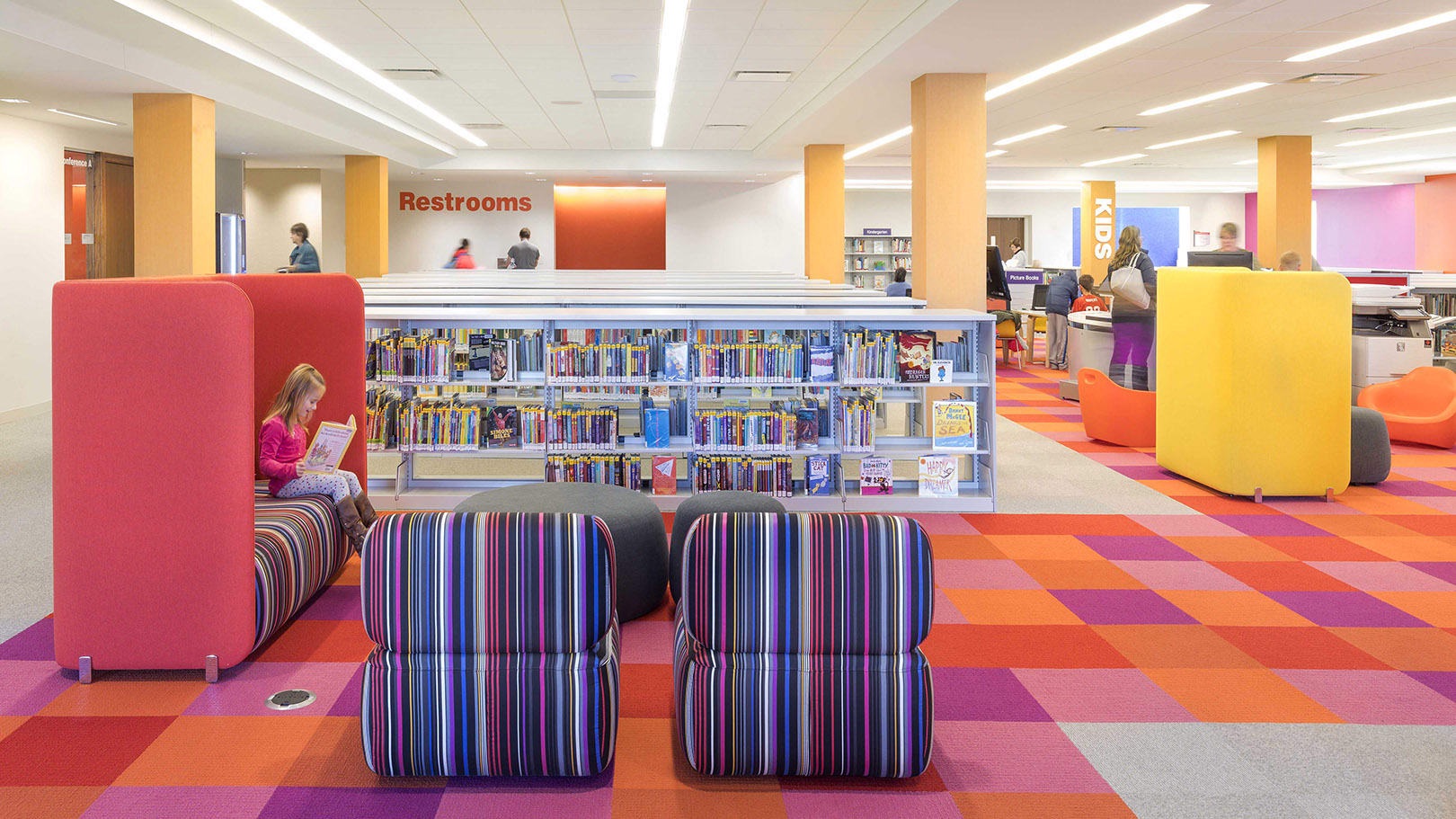
The renovation updates the existing 29,000-square-foot library, while adding 2,500 square feet of additional space. The floor plan was reconfigured to help the library meet 21st century standards for technology and programming, improve energy efficiency, and meet all life safety requirements. The lower level was remodeled to accommodate 2,900 square feet of flexible makerspace, as well as space for the archive collection. A new open stair has been included to promote visual and physical connectivity between first and second floors.
The relocation of the main entrance from the north side of the building to the southwest corner eliminates the need for steps, improves thermal performance, and provides a dynamic new face for the library. In addition, the project provides new, larger, and more dynamic areas for children and young adults; a new 150-person sub-dividable community room with a warming kitchen; and an outdoor patio adjacent to the popular library area. Photo: Paul Brokering via AIA
Laurel Branch Library; Largo, Maryland | Grimm + Parker Architects
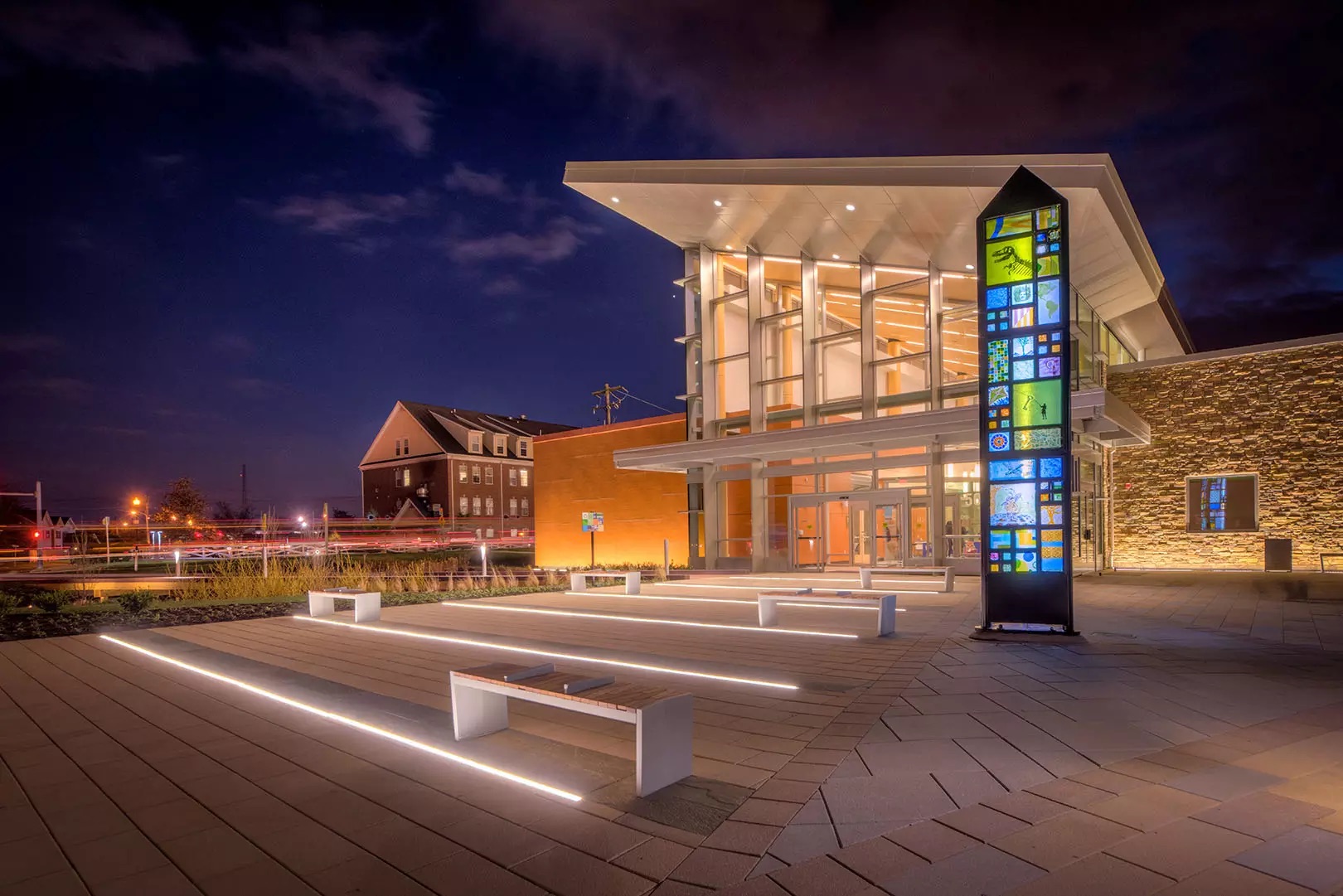
The 32,000-square-foot library replaces an existing facility, which was one of Prince George’s County’s most heavily used libraries. Its architecture provides a pedestrian-friendly solution that solidifies the library’s institutional presence while improving and respecting the park. The interior was designed to enhance the user experience through a replica paleontological dig site in the floor of the children’s area and public art pieces by local artists in other spaces. While not pursuing LEED certification, the LEED-NC v3 system provided an overarching design framework for its sustainable features. Outside, the site is a living laboratory for stormwater management and local ecosystems. Native drought-resistant plants were planted in large sweeps on the park and library grounds for maximum visual and functional impact. Flowering cherry trees echo nearby Washington, D.C., and a stand of native oaks reference the history of the site, once known as Oak Grove. Photo: Sam Kittner via AIA
Pico Branch Library; Santa Monica, California | Koning Eizenberg Architecture, Inc.
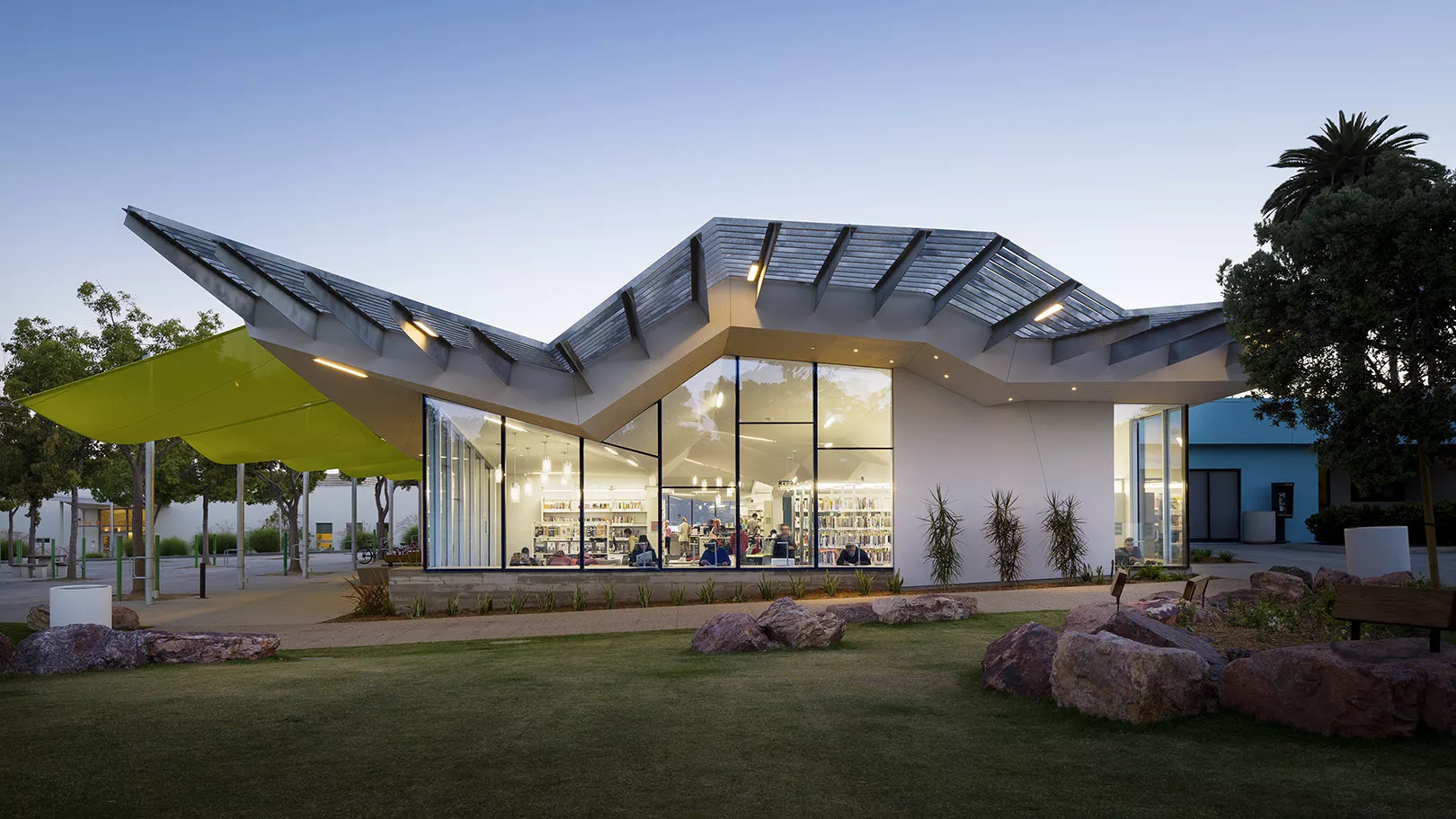
The library, located in the heart of Santa Monica’s Virginia Avenue Park, leverages its setting to encourage its use as both an educational resource and social gathering spot.
The nearly 9,000-sf library preserves the site’s existing green space and takes advantage of previously underused space to further activate the park’s event plaza. Sustainable features can be found throughout the LEED Platinum certified library, chief among them daylight harvesting and passive shading. Skylights and the library’s carved ceiling help maximize light and define the building’s architectural identity. Deep overhangs and canopies protect glass from direct sun and eliminate the need for interior shades.
Through its rainwater harvesting system, the library collects water from its roof and the roof of an adjacent building for storage in a 12,000-gallon cistern, where it is filtered and used to flush the library’s toilets. In the first six months of operation, the library increased its membership by more than 1,200 people and over 100,000 materials were checked out. Photo: Eric Staudenmaier via AIA
Tulsa City-County Central Library; Tulsa, Oklahoma | MSR Design
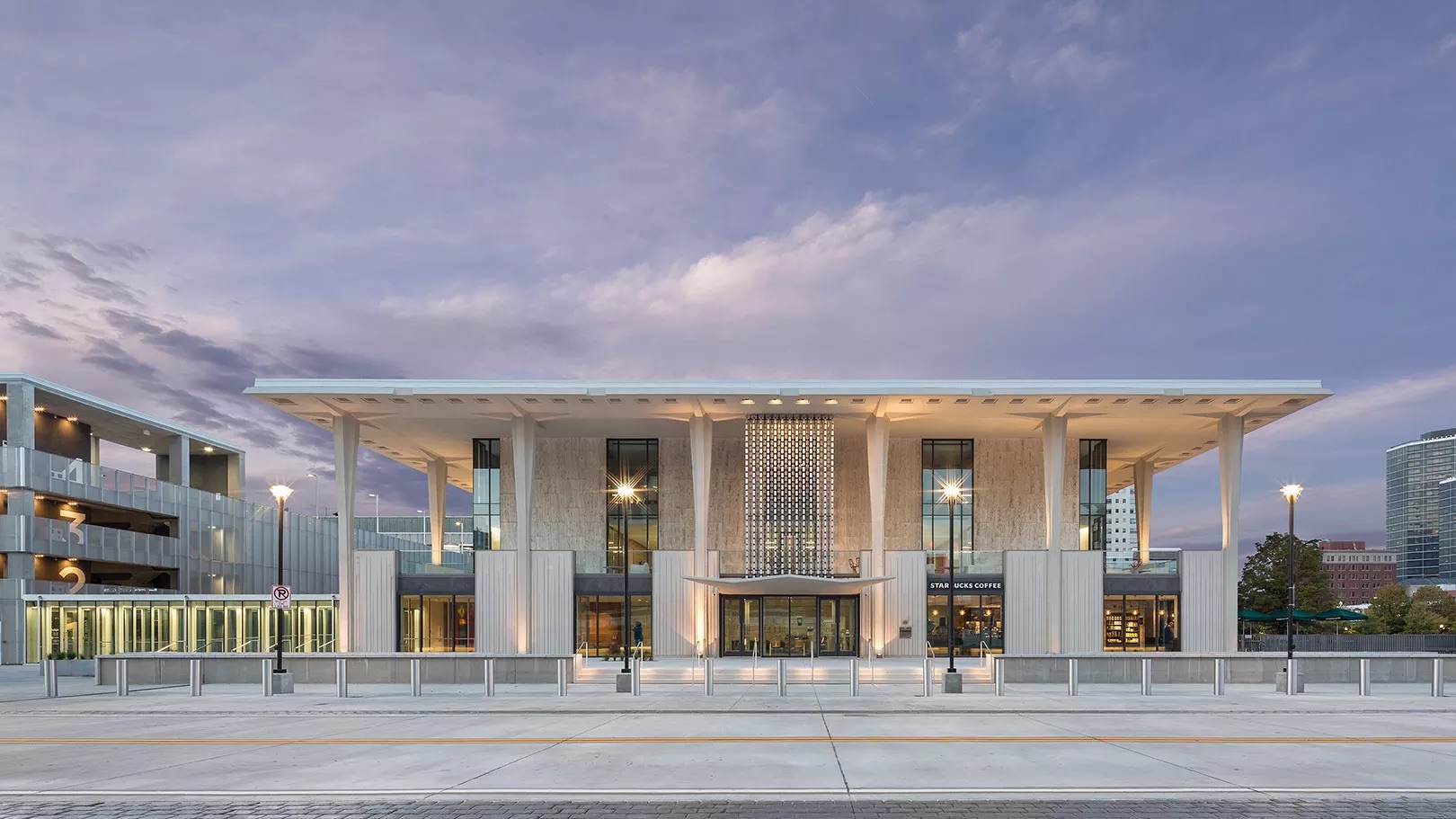
The design team approached the project with the goals of delivering a solution that responds to the needs of a 21st-century library while creating a destination that actively contributes to the city’s renewal. To that end, the project activates the exterior spaces, simplifies patron entry, and dramatically increases parking availability through a parking garage with an enclosed link to the library. Despite the addition of the 88,000-square-foot garage, the overall impervious surfaces on the site were reduced, alleviating stormwater runoff.
New cast stone panels, refurbished public art, and a thorough cleaning honor the library’s original 1965 design. Beyond the adult stacks and destination children’s area inside, the library features a mix of spaces where up to 140 people can meet and collaborate. The plaza itself, once tired and deserted, now features pervious pavers and ample seating surrounded by vegetation. Coupled with the library’s café, outdoor spaces provide seating for more than 400 people, providing regular meeting space before library hours begin. Photo: Lara Swimmer via AIA
Related Stories
| Aug 11, 2010
Portland Cement Association offers blast resistant design guide for reinforced concrete structures
Developed for designers and engineers, "Blast Resistant Design Guide for Reinforced Concrete Structures" provides a practical treatment of the design of cast-in-place reinforced concrete structures to resist the effects of blast loads. It explains the principles of blast-resistant design, and how to determine the kind and degree of resistance a structure needs as well as how to specify the required materials and details.
| Aug 11, 2010
Jacobs, CH2M Hill, AECOM top BD+C's ranking of the 75 largest federal government design firms
A ranking of the Top 75 Federal Government Design Firms based on Building Design+Construction's 2009 Giants 300 survey. For more Giants 300 rankings, visit http://www.BDCnetwork.com/Giants
| Aug 11, 2010
Manhattan's Pier 57 to be transformed into cultural center, small business incubator, and public park as part of $210 million redevelopment plan
LOT-EK, Beyer Blinder Belle, and West 8 have been selected as the design team for Hudson River Park’s Pier 57 at 15th Street and the Hudson River as part of the development group led by New York-based real estate developer YoungWoo & Associates. The 375,000 square foot vacant, former passenger ship terminal will be transformed into a cultural center, small business incubator, and public park, including a rooftop venue for the Tribeca Film Festival.
| Aug 11, 2010
Gensler, HOK, HDR among the nation's leading reconstruction design firms, according to BD+C's Giants 300 report
A ranking of the Top 100 Reconstruction Design Firms based on Building Design+Construction's 2009 Giants 300 survey. For more Giants 300 rankings, visit http://www.BDCnetwork.com/Giants
| Aug 11, 2010
Bowdoin College Museum of Art
Brunswick, Maine
Since its founding in 1794, when what is now the state of Maine was still part of the Commonwealth of Massachusetts, Bowdoin College has played a pivotal role in the educational and cultural life of Maine. Contributing to that role for more than a century has been the Walker Art Building, an 1894 McKim, Mead & White-designed structure and home to the college’s Museum of Art.
| Aug 11, 2010
Gensler among eight teams named finalists in 'classroom of the future' design competition
Eight teams were recognized today as finalists of the 2009 Open Architecture Challenge: Classroom. Finalists submitted designs ranging from an outdoor classroom for children in inner-city Chicago, learning spaces for the children of salt pan workers in India, safe spaces for youth in Bogota, Colombia and a bamboo classroom in the Himalayan mountains.
| Aug 11, 2010
ASHRAE introduces building energy label prototype
Most of us know the fuel efficiency of our cars, but what about our buildings? ASHRAE is working to change that, moving one step closer today to introducing its building energy labeling program with release of a prototype label at its 2009 Annual Conference in Louisville, Ky.
| Aug 11, 2010
Thom Mayne unveils 'floating cube' design for the Perot Museum of Nature and Science in Dallas
Calling it a “living educational tool featuring architecture inspired by nature and science,” Pritzker Prize Laureate Thom Mayne and leaders from the Museum of Nature & Science unveiled the schematic designs and building model for the Perot Museum of Nature & Science at Victory Park. Groundbreaking on the approximately $185 million project will be held later this fall, and the Museum is expected to open by early 2013.
| Aug 11, 2010
Theater Renovation—A First-Class Production
In 1985, the city of San Diego ordered the historic Balboa Theatre, its beleaguered performing arts center, to be shuttered due to seismic safety concerns. It would take another two decades to restore the landmark building.


